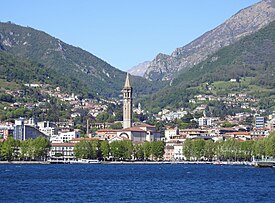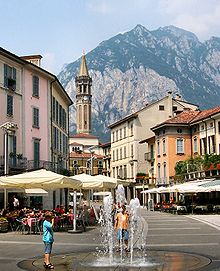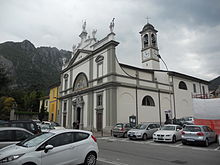Lecco
| Lecco | ||
|---|---|---|

|
|
|
| Country | Italy | |
| region | Lombardy | |
| province | Lecco (LC) | |
| Local name | Lecco | |
| Coordinates | 45 ° 51 ' N , 9 ° 24' E | |
| height | 214 m slm | |
| surface | 45 km² | |
| Residents | 48,173 (Dec. 31, 2019) | |
| Population density | 1,071 inhabitants / km² | |
| Factions | Acquate, Belledo, Bonacina, Castello, Chiuso, Germanedo, Laorca, Maggianico, Malavedo, Olate, Pescarenico, Rancio, San Giovanni, Santo Stefano | |
| Post Code | 23900 | |
| prefix | 0341 | |
| ISTAT number | 097042 | |
| Popular name | lecchesi | |
| Patron saint | Nicholas of Myra ( December 6th ) | |
| Website | Lecco | |

Lecco ( Lombard : Lècch [ˈlɛkː]; dt. Outdated: Leck ) is a municipality in Italy , capital of the province of the same name , Lecco in the Lombardy region .
geography
The capital of the province of Lecco is located at the outflow of the southeast arm of Lake Como , Lago di Lecco, 55 km northeast of Milan and 30 km east of Como. The Adda leaves the lake at Lecco to the south and then flows through the Lago di Garlate and the Lago di Olginate. The steep banks of Lake Como have only allowed the city development space to the south. Geologically, Lecco is located in the limestone of the Lombard pre-Alps, but the Ice Age glacier that came from Valtellina is at an altitude of over 800 m. ü. M. Granite - left behind boulders of sometimes enormous size, from whose location one can deduce the former thickness of the ice cover. The blocks are now under nature protection, in the past they were dismantled and used for rural house construction.
The neighboring municipalities are: Abbadia Lariana , Ballabio , Brumano (BG), Erve , Galbiate , Garlate , Malgrate , Mandello del Lario , Morterone , Pescate , Valmadrera and Vercurago .
traffic
Lecco can be reached from Milan by bus and train and has two train stations. The railway line continues north, along the east bank of Lake Como, to Colico and Valtellina . Buses take care of inner-city traffic. A cable car leads to the Piani d'Erna directly above the city.
history
Prehistory and Roman times
The oldest settlement found so far on Lake Garlate, near Vercurago, dates back to the early Iron Age , the first layers belong to the 10th century. These Celtic settlements were subsequently overrun by the Celts of the La Tène period , who came from the north over the Alps and advanced to Rome in 387. Remains of iron melts from the period between the 2nd century BC and the 1st century AD on the Piani d'Erna above Lecco also come from the Latène. It is the oldest metal production in the Alps and the iron processing industry in Lecco has survived continuously to this day.
During the time of the Roman expansion to the north, the area was part of the Limes with fortifications to protect Mediolanum , which the Romans had conquered in 222 BC.
middle Ages
Lecco was the starting point for important trade routes across the Alps and was therefore of great economic and military importance. Under the Carolingians , the Lecco area with the "Castrum Leuci" became a county under the Attonides, the descendants of Attos, who were able to hold on to power for several generations.
In 960 they were ousted by Otto I and Lecco was subordinated to the Archbishops of Milan. There were then again and again attempts to achieve more independence compared to Milan, in this period up to the 12th century the social rise of the Cives, non-aristocratic but powerful bourgeois families, also fell.
In the conflict with the Empire ( Battle of Legnano 1176) the Lecchese sided with Friedrich Barbarossa against the Lega Lombarda , because they hoped to gain more independence from Milan. The cities of the Lega achieved more internal autonomy, but recognized the sovereignty of Friedrich Barbarossa . In 1385 Gian Galeazzo Visconti took over sole control of the area after poisoning his uncle. In the course of the Milan power struggles, Lecco suffered various destruction.
Modern times
The Duchy of Milan went with the death of the last Visconti in 1447 to the family of the Sforza over who ruled as dukes to Milan and 1535th In 1515 Lombardy came to France for a short time, and in 1515 Francis I was able to win it back at the Battle of Marignano . With the extinction of the Sforza, Lecco fell under the rule of the Spaniards. This lasted until 1714, when Lombardy fell to the Habsburgs. Maria Theresa made Lecco a local center for the surrounding dioceses.
In 1797 Lecco was part of the short-lived Repubblica Cisalpina , in 1800 Napoleon conquered Lecco, and in 1804 the Cisalpine Republic became the Kingdom of Italy under Napoleon. In 1814, after its definitive defeat, the Habsburg troops recaptured Lombardy. Lecco experienced a significant boom under Austrian rule. An efficient administration was introduced, the Theresian cadastre was expanded, and the iron and silk industries made Lecco an important economic center. In 1848 Lecco followed the example of Milan's revolutionary "Cinque Giornate" and received the status of a city, which it soon lost again and only received again in 1859, when the Kingdom of Sardinia conquered Lombardy. Lecco had lost its central administrative functions under Napoleon and remained part of the Province of Como until 1992 when the Province of Lecco was re- created.
economy
Lecco's economic strength is closely linked to its history. Iron processing since Roman times has been the basis of today's metalworking industry and mechanical engineering, some of which are highly specialized companies, and the development of silkworm breeding in the 19th century left its mark on today's declining textile industry. In addition, Lecco was an important starting point for trade routes across the Alps and a trading town from an early age. The water power of the steep river valleys, where iron smiths, mills and other workshops were located, which was essential for early industrialization, no longer plays a role today.
The most important industrial companies today are:
- Icam (Industria Cioccolato e Affini Morbegno)
- The Leuci lamp factory
- Fiocchi Munizioni , production of ammunition (especially small caliber)
- Riello, production of boilers and thermal baths
- Riccardo Cassin is probably Lecco's best-known industrialist among mountaineers abroad. In 1947 he started his production of only metal equipment (hammers, pickaxes, hooks, ice screws, crampons), in 1997 the equipment company CAMP took over the Cassin label.
The once famous SAE (Società anonima elettrificazione), which built power lines, including crossing the Strait of Messina with a 220 kV line with two 255 m high masts, closed its doors in 1992. The renowned locomotive manufacturer Badoni only survived until 1993. Today (as of 2018) the Chamber of Commerce and Industry has 1,300 companies with around 9,000 employees. A larger number are active in the service sector, including retail. For Italian exports, Lecco plays an important role with its mechanical engineering, chemical products and the food industry, the sector is growing rapidly. The second most important role for the city's economy is now played by tourism, which is widely advertised.
tourism
In the city itself is the Manzoni Museum (Museo Manzoniano); The Basilica of San Nicolò, which has one of the tallest church towers in Italy (96 m), is located in the old town, which is well worth seeing; it can be climbed over 380 steps. Lecco is the base for shipping on Lake Lecco , especially for the ships to Bellagio on the headland between the arms of Lake Como and Lake Lecco. The city has a marina.
Lecco with the surrounding mountains is a historical center of Italian alpinism and still has a lively climbing scene today. Immediately above the city rises the wall of the Corna di Medale , where famous mountaineers like Riccardo Cassin earned their first spurs with first ascents. On the Grigne, on the Monte Resegone, the Piani d'Erna and other mountains in the area there is a large number of easy to demanding via ferratas.
Easier hikes lead to the surrounding mountains, especially the art-historically interesting ascent to the former monastery of San Pietro al Monte in Civate , the art-historically and historically interesting hike to Monte Barro (remains of defensive towers of the Goths ), which is an island mountain between the lake and the The hilly landscape of the Brianza offers an extraordinary view, the mountain hike to the Monte Resegone (1875 m), which can be shortened considerably with the cable car to the Piani d'Erna, to the Monte Due Mani (1656 m), and some very long hikes on the Grigne: Grigna meridionale or Grignetta, and Grigna settentrionale or Grignone, (2410 m), the Monte Moregallo (1276 m); Excursions in Valsassina , where there is also a small ski area, and more.
Twin cities
-
 Mâcon , France , since 1973
Mâcon , France , since 1973 -
 Overijse , Belgium , since 1981
Overijse , Belgium , since 1981 -
 Igualada , Spain , since 1990
Igualada , Spain , since 1990 -
 Szombathely , Hungary , since 1995
Szombathely , Hungary , since 1995 -
 Mytishchi , Russia , since 2005
Mytishchi , Russia , since 2005 -
 Bochum , Germany , since 2009 (cooperation agreement)
Bochum , Germany , since 2009 (cooperation agreement)
Others
The place is one of the settings of the novel I Promessi Sposi by Alessandro Manzoni .
Lecco was Alpine City of the Year 2013.
Honorary citizen
- Gawriil Abramowitsch Ilisarow (1921–1992), Soviet orthopedist
- 1989: Alfonsas Svarinskas (1925–2014), Lithuanian priest, dissident and politician
Personalities
Sorted chronologically by year of birth.
- Giovanni Antonio Codolo (* around 1470 in Lecco; † shortly before 1547 there), painter
- Antonio Ghislanzoni (1824-1893), writer and librettist
- Antonio Stoppani (1824-1891), geoscientist
- Bruno Galli-Valerio (1867–1943), director of the laboratory for bacteriology, experimental pathology and hygiene at the University of Lausanne
- Nino Castelli (1898–1925), ski jumper and rower
- Giovanni Battista Cesana (1899–1991), religious, Bishop of Gulu
- Riccardo Cassin (1909–2009), mountaineer and industrialist
- Ennio Morlotti (1910–1992), painter
- Giancarlo Badessi (1928–2011), actor
- Carlo Mauri (1930–1982), mountaineer, adventurer and documentary filmmaker
- Nino Castelnuovo (born 1936), actor
- Fabio Buzzi (1943–2019), motorboat designer and motorboat racer
- Alfredo Chiàppori (* 1943), comic artist
- Roberto Castelli (* 1946), politician
- Roberto Formigoni (* 1947), politician
- Walter Maria de Silva (* 1951), car designer
- Corrado Colombo (* 1956), filmmaker
- Luca Fusi (* 1963), soccer player and coach
- Laura Bruschini (* 1966), beach volleyball player
- Antonio Rossi (* 1968), canoeist
- Eluana Englaro (1970-2009), coma patient
- Gian Matteo Fagnini (* 1970), racing cyclist
- Anselmo Robbiati (* 1970), football player
- Massimo Codol (* 1973), racing cyclist
- Franco Sancassani (* 1974), rower
- Maria Luisa Riva (* 1978), ski mountaineer
- Gabriele Bosisio (* 1980), racing cyclist
- Silvia Valsecchi (* 1982), cyclist
- Elisabetta Sancassani (* 1983), rower
- Elisabetta Tona (* 1984), soccer player
- Marco Bonanomi (* 1985), racing driver
- Daniele Padelli (* 1985), football player
- Giorgio Brambilla (* 1988), racing cyclist
- Federico Viviani (* 1992), football player
- Andrea Conti (* 1994), soccer player
- Manuel Locatelli (* 1998), football player
See also
literature
- Anna Ferrari-Bravo, Paola Colombini: Guida d'Italia. Lombardia (esclusa Milano). Milano 1987, pp. 323-330.
- Lombardia - Touring club italiano, Touring Editore (1999), ISBN 88-365-1325-5 , Lecco Online in Italian
Web links
- Information on Lecco
- Lecco on lombardia.indettaglio.it (Italian)
- Lecco on tuttitalia.it/lombardia (Italian).
Individual evidence
- ↑ Statistiche demografiche ISTAT. Monthly population statistics of the Istituto Nazionale di Statistica , as of December 31 of 2019.
- ↑ E.Hlawitschka: Franks, Alemanni, Bavarians and Burgundians in northern Italy (774-926) , Freiburg i.Br., 1960. S. 138 ff, 249, 284th.
- ↑ La Lombardia medioevale. Retrieved May 20, 2018 .
- ↑ La Lombardia medioevale. Retrieved May 20, 2018 .
- ^ Lecco, Alpine City of the Year
- ↑ Codoli, Giovanni Antonio . In: Ulrich Thieme (Hrsg.): General Lexicon of Fine Artists from Antiquity to the Present . Founded by Ulrich Thieme and Felix Becker . tape 7 : Cioffi – Cousyns . EA Seemann, Leipzig 1912, p. 158 ( Textarchiv - Internet Archive ).






